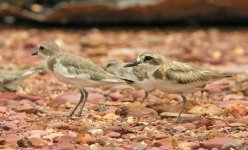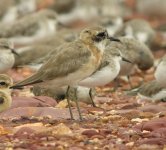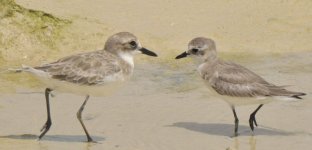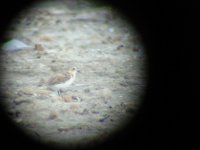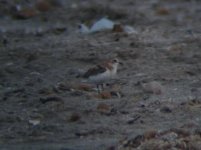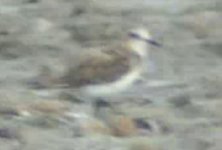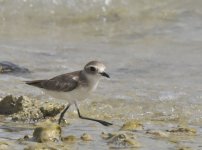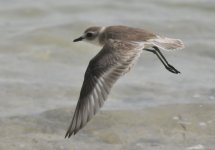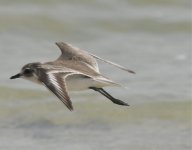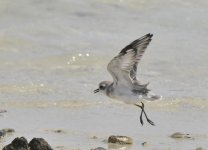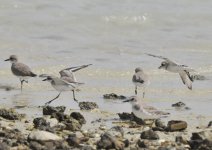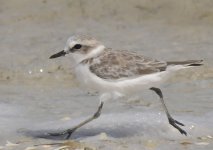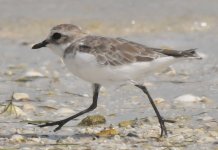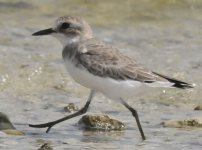I wouldn't id Dave's bird as a Lesser, mostly because of the features mentioned by Dave himself. Because of the more squarish head, it also looks a lot less cute than a typical Lesser Sandplover (in contrast to the Virginia bird, which looks very cute in most of the photos). However, the bill shape isn't typical for GSP either (and like mentined, the stage of the moult fits better Lesser), so I'm not sure about the id.
-
Welcome to BirdForum, the internet's largest birding community with thousands of members from all over the world. The forums are dedicated to wild birds, birding, binoculars and equipment and all that goes with it.
Please register for an account to take part in the discussions in the forum, post your pictures in the gallery and more.
You are using an out of date browser. It may not display this or other websites correctly.
You should upgrade or use an alternative browser.
You should upgrade or use an alternative browser.
Sand-Plover identification, Virginia, USA (1 Viewer)
- Thread starter Microtus
- Start date
More options
Who Replied?Dave B
Well-known member
Dave
interesting to say the least - two questions - are all your Lesser schaeferi if so can we can assume the one in front of the subject bird is OK for that ID
Secondly do you have a close up picture featuring a Greater from your location for comparison
Hi Howard,
All the birds I have ever positively id'ed here are 'schaeferi', so yes, I would assume the one on front is also.
Secondly, here's a close-up of a Greater taken the same day (unusually, with some remnants of breeding plumage). There are others here and here.
Cheers
Dave
Attachments
Dave B
Well-known member
I wouldn't id Dave's bird as a Lesser, mostly because of the features mentioned by Dave himself. Because of the more squarish head, it also looks a lot less cute than a typical Lesser Sandplover (in contrast to the Virginia bird, which looks very cute in most of the photos). However, the bill shape isn't typical for GSP either (and like mentined, the stage of the moult fits better Lesser), so I'm not sure about the id.
Hi CAU
Here's another Lesser (not the same bird I don't think, but very similar). In certain postures, Lessers can look quite square-headed, but still lack the 'out-of-proportion' look of Greaters.
What do you think of this one?
Cheers
Dave
Attachments
Hi Dave, your second bird indeed looks like a Lesser Sandplover. The slightly shorter bill, the more defined bulb at the tip of the bill and the lack of a clear nail make it look at lot more straightforward to me. I'd now agree that also your first bird is probably a LSP (but with an extreme bill), given its similarity to the second bird.
Howard King
Well-known member
For me at least these pictures illustrate just how difficult and complex an issue the ID for these two species is -- I have read through everything I can get my hands on and at the end of the day remain to a certain degree undecided on certain ID pointers mentioned within this thread and what I have read.
If I go to the shore I can guarantee seeing at least one Greater and a Lesser, almost twelve months of the year. Without wanting to sound patronizing and no offense to anyone is intended - I never give thought to; if an isolated bird is cute or balanced, square head or such - I look to the bill first and foremost - irrespective of my impression of size of the bird or length of the bill - if the culmenary bulge or knobbly bit on the bill (1) if it is short Lesser (2) if it looks like it is up to half way Greater - then I look to the shape of the tip for confirmation. Applying this simple rule to Dave's bird one can only conclude Dave is right on his ID's - simplistic - yes -
For birds which remain unidentifiable or in question I then start looking at the Jizz of the bird - first the wing and flanks, how these lay on the bird - just look at the pictures of each species and this becomes a point worthy of note - and then the balance of the bird about the point where the legs join the body and ask how much bulk has the bird in front or behind. If I can't sort it then I move on... whats one more or less here of either species in the thousands we have. This might not help identifying an isolated vagrant somewhere but it is to me the best place to start to resolve the ID.
Comments in various texts such that birds with black or dark legs will be Lesser, or have Long legs over short legs or my pet hate, those showing some post breeding colour will be Lesser. Those with big eyes will be Greater, Greater looks ugly and is ungainly or has a square head - all these are indicators only that in my experience are prone to error.
While out here these last few day (we currently have a Holiday) Eid Mubarak one and all, I made this little compilation - A bog standard Greater and a bog standard Lesser - but they do illustrate I feel the points I make - What people have to remember is that in either species as Dave's pictures show there are exceptions but to end what are the chances of one of these exceptions being the vagrant over the bog standard.
If I go to the shore I can guarantee seeing at least one Greater and a Lesser, almost twelve months of the year. Without wanting to sound patronizing and no offense to anyone is intended - I never give thought to; if an isolated bird is cute or balanced, square head or such - I look to the bill first and foremost - irrespective of my impression of size of the bird or length of the bill - if the culmenary bulge or knobbly bit on the bill (1) if it is short Lesser (2) if it looks like it is up to half way Greater - then I look to the shape of the tip for confirmation. Applying this simple rule to Dave's bird one can only conclude Dave is right on his ID's - simplistic - yes -
For birds which remain unidentifiable or in question I then start looking at the Jizz of the bird - first the wing and flanks, how these lay on the bird - just look at the pictures of each species and this becomes a point worthy of note - and then the balance of the bird about the point where the legs join the body and ask how much bulk has the bird in front or behind. If I can't sort it then I move on... whats one more or less here of either species in the thousands we have. This might not help identifying an isolated vagrant somewhere but it is to me the best place to start to resolve the ID.
Comments in various texts such that birds with black or dark legs will be Lesser, or have Long legs over short legs or my pet hate, those showing some post breeding colour will be Lesser. Those with big eyes will be Greater, Greater looks ugly and is ungainly or has a square head - all these are indicators only that in my experience are prone to error.
While out here these last few day (we currently have a Holiday) Eid Mubarak one and all, I made this little compilation - A bog standard Greater and a bog standard Lesser - but they do illustrate I feel the points I make - What people have to remember is that in either species as Dave's pictures show there are exceptions but to end what are the chances of one of these exceptions being the vagrant over the bog standard.
Attachments
phil baber
Clipped Wing

IMO Lesser SP.
Just a whiff of Caspian about it!
Just a whiff of Caspian about it!
Howard King
Well-known member
Can only speculate given the quality of the image I personally would not commit to either - superficially the bird appears to be fairly square on to the camera giving a short billed appearance but when I examined the images in photoshop "the angle of the dangle" wasn't quite as I expected - further I could not determine myself any other key features to fall of the fence one way or the other.
phil baber
Clipped Wing

Bring this back to the top again!
Anyone else with opinions on the bird above?
I'm still stuck on Lesser SP or Caspian. :-C
Anyone else with opinions on the bird above?
I'm still stuck on Lesser SP or Caspian. :-C
The Hairy Highlander
Well-known member
Bring this back to the top again!
Anyone else with opinions on the bird above?
I'm still stuck on Lesser SP or Caspian. :-C
For me, it's a LSP - The bird looks fairly 'squat' and the bill looks to short. The legs also look too short and dark for caspian, mind, i'm far from an expert and this is just the impression i'm getting from the photo's....
rockfowl
Mark Andrews
With regards Macrourus posting,
It looks rather Lesser SP like to me too but without further images I wouldn't be over committed. I think Caspian can be ruled out as it doesn't appear 'open-faced' , or particularly capped and the bill, doesn't appear quite long or thin enough IMO.
http://www.alsirhan.com/Blog/wp-content/2008/09/chaasi7605.jpg
It looks rather Lesser SP like to me too but without further images I wouldn't be over committed. I think Caspian can be ruled out as it doesn't appear 'open-faced' , or particularly capped and the bill, doesn't appear quite long or thin enough IMO.
http://www.alsirhan.com/Blog/wp-content/2008/09/chaasi7605.jpg
Last edited:
The birder who has found it its a very good one, mostly on shorebirds, and his own original ID was LSP.... surely not at all a Caspian....The only doubt was about a small billed male columbinus GSP...also there were concern about the already missing summer plumage more a pro GSP chacarter but it seems from this discussion is not so 100% important...also the bird may well has been a 1st summer as it seems from the wing moult in youtube video available...therefore the summer plumage is not a problem.
However, being a 1ts national record in case of LSP I think we have simply not enough material here to be 100% sure.
I would be happy to have opinion from KM and HL or Erik H.
Thanks
Andrea
However, being a 1ts national record in case of LSP I think we have simply not enough material here to be 100% sure.
I would be happy to have opinion from KM and HL or Erik H.
Thanks
Andrea
rockfowl
Mark Andrews
The birder who has found it its a very good one, mostly on shorebirds, and his own original ID was LSP.... surely not at all a Caspian....The only doubt was about a small billed male columbinus GSP...also there were concern about the already missing summer plumage more a pro GSP chacarter but it seems from this discussion is not so 100% important...also the bird may well has been a 1st summer as it seems from the wing moult in youtube video available...therefore the summer plumage is not a problem.
However, being a 1ts national record in case of LSP I think we have simply not enough material here to be 100% sure.
I would be happy to have opinion from KM and HL or Erik H.
Thanks
Andrea
Are these he only images Andrea?
Howard King
Well-known member
Found the videos of the bird - short and wobbly on Utube
http://www.youtube.com/watch?v=vYfYiy137ZA&feature=related
well worth a look
http://www.youtube.com/watch?v=vYfYiy137ZA&feature=related
well worth a look
Howard King
Well-known member
Howard King
Well-known member
It is a great shame that the video is so jumpy, it still looks and feels like a LSP.
It does show the dangers of videograb though Howard, its bill has grown substantially!
I agree I found I could get shots that proved its ID both ways - totally inadequate as evidence for a country first but thats up to someone else thankfully - However one thing I noted was a section where it is seen running another where it does a hop skip and a jump - in both sections it moves and acts more like a LSP rather than a GSP -
Hi Andrea,
I'm not sure if you already asked me to comment on this bird some time ago, if so my apologies for not having come back to you on it.
I have to say, my immediate impression is that this actually not a sand plover at all, but a Kentish. I have spent a few minutes looking at the videos on U-tube and these seem to confirm that, contrary to the impression given in the still you attached to your initial post, the bird actually has a broad white collar. Apart from this the head-pattern, and shape of the white forehead, bill-size etc. all remind me very much of Kentish...
If I get a chance I'll go through the video-clips more carefully and try to locate the particular points at which the Kentish-like collar is most obvious.
All the best,
Killian
I'm not sure if you already asked me to comment on this bird some time ago, if so my apologies for not having come back to you on it.
I have to say, my immediate impression is that this actually not a sand plover at all, but a Kentish. I have spent a few minutes looking at the videos on U-tube and these seem to confirm that, contrary to the impression given in the still you attached to your initial post, the bird actually has a broad white collar. Apart from this the head-pattern, and shape of the white forehead, bill-size etc. all remind me very much of Kentish...
If I get a chance I'll go through the video-clips more carefully and try to locate the particular points at which the Kentish-like collar is most obvious.
All the best,
Killian
Howard King
Well-known member
Kentish ummm that could well explain the way it moves - as always with Sand Plovers they can be different - LSP can show at times a distinct collar - I offer these photos in evidence for that feature Don't think they are must use in this case I will put them here more as an aid for future reference - help yourself and copy any you wish.
However may I make a suggestion for when filming video in a wobbly situation don't zoom the two just don't go together - zoom with what ever recording device you have switched off - then restart - better a long steady shot than one that only distracts from the proof of ID.
However may I make a suggestion for when filming video in a wobbly situation don't zoom the two just don't go together - zoom with what ever recording device you have switched off - then restart - better a long steady shot than one that only distracts from the proof of ID.
Attachments
Last edited:
Howard King
Well-known member
Users who are viewing this thread
Total: 2 (members: 0, guests: 2)




